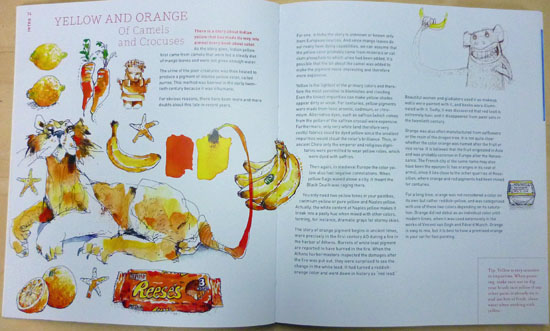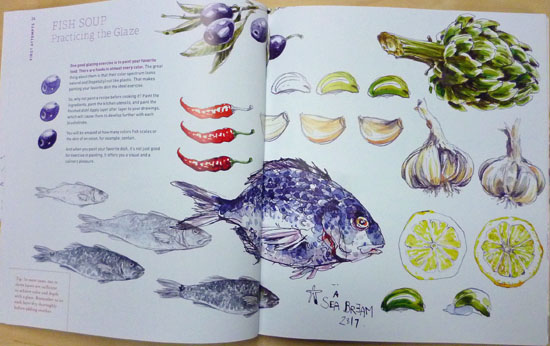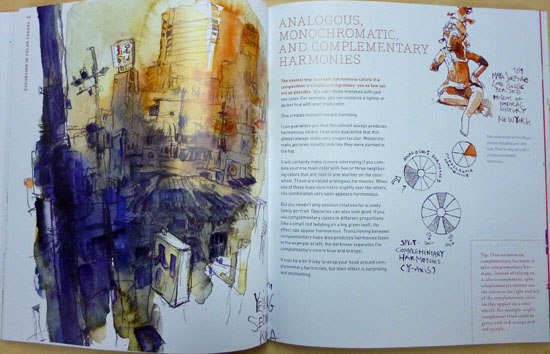 The complete title of the North American edition of this book is Urban Watercolor Sketching: A Guide to Drawing, Painting, and Storytelling in Color by Felix Scheinberger. And if the recent flood of books about urban sketching and art journaling isn’t an indication that what we do has hit the mainstream, the title of this book most certainly let’s us know that “urban sketching” has become a marketing tool, like ‘new and improved.’
The complete title of the North American edition of this book is Urban Watercolor Sketching: A Guide to Drawing, Painting, and Storytelling in Color by Felix Scheinberger. And if the recent flood of books about urban sketching and art journaling isn’t an indication that what we do has hit the mainstream, the title of this book most certainly let’s us know that “urban sketching” has become a marketing tool, like ‘new and improved.’
Why do I say that? Because the only place that urban sketching is mentioned in this book is on the cover. The author never references either urban sketching or storytelling. Mr. Scheinberger wrote a book that would be better titled “Watercolor Sketching: The Effective Use of Watercolor in Sketching.” And lest you think I’m faulting the author, the book was written in German and the original title translates to Watercolor for Illustrators (I think). It ain’t his fault. The sad thing is that I suspect the book would appeal to a wider audience if they’d put that on the cover rather than tried to fool people into thinking it an urban sketching book.
Enough with the grousing over publisher folly. This is a REALLY GOOD BOOK! Felix Scheinberger is an illustrator of children’s books and his loose style, with both pen and watercolor are wonderful to behold. The emphasis of the book is on color and its use. It’s not a step-wise approach to watercolor techniques, but more of a mental toolkit for how to view and use watercolors.
In addition to discussions of color itself, Scheinberger talks about making decisions about color combination, using color sparingly, creating harmonies, atmosphere, and composition. His discussion of materials assumes the use of single sheet or blocks of watercolor paper so brush talk revolves around that sort of presentation rather than small sketchbooks. There is no discussion of pencil/pen, which allows him more space to discuss color philosophy and decisions.
The name of this book may be way off base but if you’re an urban sketcher you’ll still find much that will float your boat. Scheinberger’s style is very loose but he turns his art towards urban landscapes quite often so his advice applies to these subjects. I never sketch outside of a sketchbook and yet I thoroughly enjoyed this book and highly recommend it.





There are more then one reviews where Felix’s book is considered anything but an urban sketching book.
Looking for a definition I found :
“Urban Sketchers (USk) is a global community of artists that practice drawing on location in cities, towns and villages they live in or travel to.”
I have the book, I read it and for me it is as “urban” as it can get!!!
I don’t understand why people don’t see it ?? Every the other page has drawings done on locations in cities, tows and villages all over the world (about 3 or 4 are done even in Romania). Why is not urban ? Because he used sketches of food, art supplies, animals, jars, samples of colours, girls at cabaret etc., along with drawing fish markets, castles, churches, houses and streets, mountains, etc…??? Is it because couple of drawings were rendering a farm and a shepard ??? Is that the reason to disqualified this book from “its very own title” ?
Puzzled-huge admirer-of Felix
Nik, each of us has our own definition of what urban sketching is, it seems. That’s fine. But “urban sketching” as defined by the organizaton is more than doing art in a city. For instance, from the Urban Sketcher’s manifesto comes:
1) Our drawings are a record of time and place.
2) We are truthful to the scenes we witness.
Now, Felix spends a great deal of time showing people how to modify what they’re looking at into something else. Nothing wrong with that, of course, but this approach defies the first two dictums of the urban sketcher manifesto.
More to the point, however, Felix never once uses the term “urban sketcher” in the book. The German book makes no mention of urban sketching in its title. So, while it may offend you that many of us don’t see it as an urban sketching book, I suspect Felix never saw it as one.
Further, having read the book, I suspect Felix would say that following that manifesto is far too limiting for his tastes. And that is the strength of his book. It goes well beyond sketching what you see. Therefore, I stand by my comments.
Cheers — Larry
A good review Larry and a good point made about the publishers folly. Róisín Curé also reviewed the book did you read it? I think the author would be happy if even some of the 18,000 plus members of the “Official” USk fraternity bought his book along with all of the other “Unofficial” urban sketchers around the world. There is no doubt though, that Urban Sketching has become a bit of a catchphrase, probably making all the traditional plein-air artists wondering what the fuss all about. I’m still waiting for my copy.
Hmm…I haven’t seen Roisin’s review. It wasn’t on her blog. Where did she write it? I hope I’m wrong but I fear that urban sketching is quickly becoming a ‘fine art of cities’ world. When Gabi came up with the idea he was clearly talking about the sort of journalistic sketching that he was doing, not people with easels. I guess time will tell but more and more I feel that I’m no longer doing what ‘urban sketchers’ are doing in spite of the fact that everything I do is done on location in a city. Go figure.
Cheers — Larry
HI Larry, Thanks for the review. I think watercolor, as a standalone topic, warrants an entire book. Watercolor is much more than coloring in the spaces. I find it, frankly, intimidating. Another book that focus on the big, important issues is “Watercolor Painting” by Tom Hoffman. No step by step instructions and very little technique tips. But many thoughts on how to analyze and translate a scene into a sequence of watercolors on a page. Thoughts that are applicable to painting or drawing in general. Keep up the good work. Jeff
Probably needs more than one, JD 🙂 To me, the problem with watercolors, when viewed from the outside, is two-fold. First is that “watercolors” is a medium, not a way of painting. Within watercolors there are numerous ways to approach the use of this medium and you need to identify what you want to do and then get books that describe that method. For instance, the differences between using watercolors wet-in-wet to produce large, loose scenes has little relevance to someone wanting to do pen/ink/watercolor illustration.
The second problem, in my view, is that most of the books are designed to provide silver bullet solutions. I’ve taken to calling them dream books. They spend several chapters introducing you to a pencil, paper, and watercolors. Then they provide a color wheel. Then each subsequent chapter says “start with a drawing of your scene” and proceeds to provide you with 4-6 photos of the “stages” of the painting. Completely worthless in my opinion as they teach nothing that would move you from a neophyte to being able to do what the author is accomplishing. This is why I like Scheinberger’s book so much. It doesn’t do any of that but rather tells you about colors, how they interact, and what to do with them.
I’m not familiar with Hoffman’s book but admit to being confused. The description of the book explicitly says there are step-by-step instructions and yet you say there are none. In my opinion, if you haven’t done any watercolor, you don’t need a book on ‘translating a scene’ but rather a book on how to USE watercolors. Watercolor is a medium that pivots on the ability to mix paint with water to achieve results. Learning that mixing process, I think, requires a limited palette and a lot of time and paper. The limited palette allows you to gain control over color mixing without confusion and you’ve simply got to play with the water-color-paper mix to learn what you need to do to achieved.
One last thing. You said that watercolor is more than coloring in the spaces. I think you’re right but this is a great place to start. You’ll find that learning how to fill in a space with an even color, or uneven color is a great way to learn what I just discussed. Give them a try.
Cheers — Larry